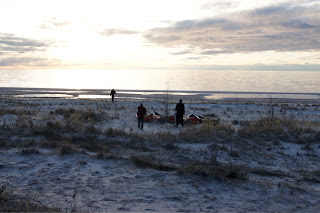The next morning, the weather and the river both changed. The blue sky returned and the temperature rose. The boulder fields were replaced by shallow braided channels running through the sand-choked beginnings of the Williams River delta. We paddled from side to side in search of channels deep enough to keep afloat. A few kilometres "as the crow flies" turned out to be about three times the distance "as the canoeist paddles."
After a couple of hours of this rather slow progress, we found the easterly channel to Lake Athabasca. It was like turning onto a super highway: it was relatively deep and possessed a good current. After a short time moving at this increased pace, we pulled out, sat up on the bank and basked in the sunshine as we enjoyed a late morning fruit and trail mix break. On a very short hike up the game trail for a pee break, I noticed that a beaver had recently been interrupted in the middle of a tree-felling, perhaps by us. The beaver had already reduced the trunk's diameter by two-thirds. I mentioned this to the group upon my return. About five minutes later, there was a sudden crack and the tree I had mentioned crashed just a couple of feet from two of our canoes. It just goes to show, beaver fever isn't the only potential hazard that our national symbol presents to canoeists!
We packed up again and within half an hour we were emerging into Lake Athabasca, but the river was not yet ready to let us go. We were once again fighting to find a channel through the seemingly unending sand bars and were forced to head well out into the massive lake before we could begin to head east toward our pick-up point.

Once free of the sand bars, we headed to the south shore for lunch. There, we planned our strategy. We wanted to take advantage of three-quarter tailwind we had as we feared a change in wind direction. The trouble was, many of us were tired. We decided to set some doable goals. As we skipped from point to point along the shoreline, we gained strength and set new goals. The wind slowed and the lake became almost glassy.


As we paddled along the Athabasca shoreline, Mike trolled and was rewarded with a great lake trout.
Our progress eastward was heralded by Arctic terns and flocks of shore birds that seemed to swoop down on both sides of each canoe, swirl around and come back for a second and third look.
We finally stopped just six kilometres short of the final portage into Cantara Lake. In terms of distance travelled, the day was a stunning contrast to the previous one when we had managed less than five kilometres.
We camped on the beach and enjoyed Mike's lake trout, the tranquil views and one beautiful, if rather late, sunset.



No comments:
Post a Comment